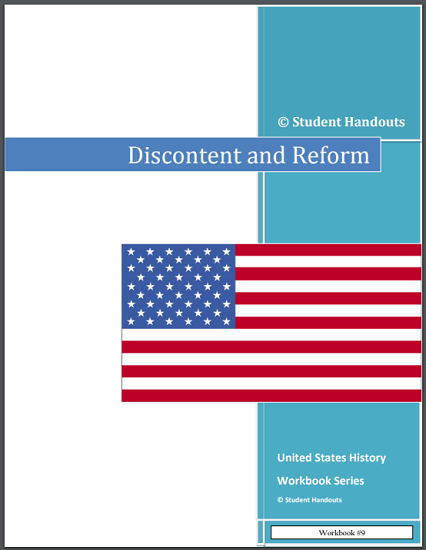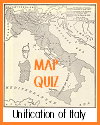| Workbook #9 - Discontent and Reform |
| United States History > American History Workbooks > U.S. History Workbooks for High School |
| This particular workbook covers the rise of populism, the Grange, William Jennings Bryan, William McKinley, the labor movement, Samuel Gompers, Great Rail Strike of 1877, Haymarket Riot of 1886, Pullman Strike (1894), Wobblies, Theodore "Teddy" Roosevelt, Progressives, muckraker, Upton Sinclair, Theodore Dreiser, Frank Norris, Lincoln Steffens, Jane Addams, Square Deal, Elkins Act (1903), Hepburn Act (1906), Pure Food and Drug Act (1906), Meat Inspection Act (1906), conservation movement, William Howard Taft, Woodrow Wilson, Underwood Tariff (1913), Federal Reserve Act (1913), Clayton Antitrust Act, Adamson Act, Ellis Island, the "new" immigrants, and much more. This is 23 pages in length. The answer key is below. Click here to print. |
 |  |
|---|
|
1 Agrarian Distress and the Rise of Populism 1. Heavy supply (overproduction) 2. Excessive railroad freight rates to move their goods to market; protective tariff drove up the price of farm equipment; heavy debt loads; droughts caused by hostile weather 3. Tenant farmers who give up to half of their crop to a landowner for rent, seed, and essential supplies 4. Overproduction by tenant farmers who hoped that increased planting would get them out of debt 5. Patrons of Husbandry, the first organized effort to address general agricultural problems; launched in 1867 by employees of the U.S. Department of Agriculture 6. Farmers' Alliances 7. Colored Farmers National Alliance 8. Nationalization of the railroads, a low tariff, loans secured by non-perishable crops stored in government-owned warehouses, and currency inflation through Treasury purchase and the unlimited coinage of silver at the "traditional" rate of 16 ounces of silver to one ounce of gold 9. The 16:1 price ratio was nearly twice the market price for silver; a policy of unlimited purchase would denude the U.S. Treasury of all its gold holdings, sharply devalue the dollar, and destroy the purchasing power of the working and middle class 10. Bank failures abounded in the South and Midwest; unemployment soared and crop prices fell badly 11. William Jennings Bryan 12. William McKinley 2 The Struggles of Labor 1. Low wages, long hours, hazardous working conditions, and high levels of unemployment during periodic economic crises 2. B - false 3. A - true 4. Many social thinkers believed that both the growth of large business at the expense of small enterprise and the wealth of a few alongside the poverty of many was "survival of the fittest," and an unavoidable by-product of progress 5. A - true 6. Noble Order of the Knights of Labor 7. Samuel Gompers 8. Increasing wages, reducing hours, and improving working conditions 9. Rail workers across the nation went out in response to a 10-percent pay cut; attempts to break the strike led to rioting and wide-scale destruction in several cities; federal troops had to be sent to several locations before the strike was ended 10. Someone threw a bomb at police about to brek up an anarchist rally in support of an ongoing strike at the McCormick Harvester company; in the ensuing melee, seven policemen and at least four workers were reported killed, and some 60 police officers were injured 11. Strike by the Amalgamated Association of Iron, Steel, and Tin Workers; group of 300 Pinkerton detectives working for Andrew Carnegie's steel works fought a fierce and losing gun battle with strikers; National Guard called in to protect non-union workers and break the strike; unions not let back into the plant until 1937 12. Reaction to wage cuts at the Pullman company; supported by the American Railway Union; tied up much of the country's rail system; U.S. Attorney General Richard Olney deputized over 3,000 men in an attempt to keep the rails open; federal court injunction against union interference with the trains; President Grover Cleveland sent in federal troops to break the strike 13. Industrial Workers of the World (IWW) 14. Answers will vary |
|
3& The Reform Impulse 1. C - Buffalo 2. Theodore "Teddy" Roosevelt 3. The excesses of 19th-century capitalism and political corruption 4. Greater democracy and social justice, honest government, more effective regulation of business, and a revived commitment to public service 5. Journalists who crusaded for Progressive causes by writing trenchant articles dealing with trusts, high finance, impure foods, and abusive railroad practices 6. Upton Sinclair 7. Theodore Dreiser 8. Frank Norris 9. Lincoln Steffens 10. A prominent social critic 4 Roosevelt's Reforms 1. Made employers legally responsible for injuries sustained by employees at work 2. Roosevelt's determination to deal with problems on a national scale 3. Greatly restricted the railroad practice of giving rebates to favored shippers 4. His striking personality; his trust-busting activities captured the popular imagination; bounding prosperity of the country at this time 5. Gave the Interstate commerce commission (ICC) real authority in regulating rates, extended the ICC's jurisdiction, and forced the railroads to surrender their interlocking interests in steamship lines and coal companies 6. Prohibited the use of any "deleterious drug, chemical, or preservative" in prepared medicines and foods 7. Mandated federal inspection of all meat-packing establishments engaged in interstate commerce 8. Increased the area of timberland for preservation and parks to 59,200,000 hectares systematic efforts to prevent forest fires and to re-timber denuded tracts 5 Taft and Wilson 1. C - William Howard Taft 2. Authorized a federal income tax 3. Mandated the direct election of senators by the people instead of by state legislatures 4. Because of its liberal constitution 5. D - Woodrow Wilson 6. Provided substantial rate reductions on imported raw materials and foodstuffs, cotton and woolen goods, iron and steel; it removed the duties from more than a hundred other items 7. Divided the country into 12 districts, with a Federal Reserve Bank in each, all supervised by a national Federal Reserve Board with limited authority to set interest rates; assured greater flexibility in the money supply and made provision for issuing federal-reserve notes to meet business demands 8. Interlocking directorates, price discrimination among purchasers, use of the injunction in labor disputes, and ownership by one corporation of stock in similar enterprises 9. B - farmers 10. A - true 11. A - authorized allowances to civil service employees for disabilities incurred at work 12. A - Adamson Act 13. Answers will vary 6 A Nation of Nations 1. Ellis Island 2. From early on, Americans viewed immigrants as a necessary resource for an expanding country 3. Potato blight in Ireland 4. Curtailed the influx of newcomers with quotas calculated on nation of origin 5. A - 270,000 6. To find work, higher wages, and improved education and health care for their families |
| United States History > American History Workbooks > U.S. History Workbooks for High School |









